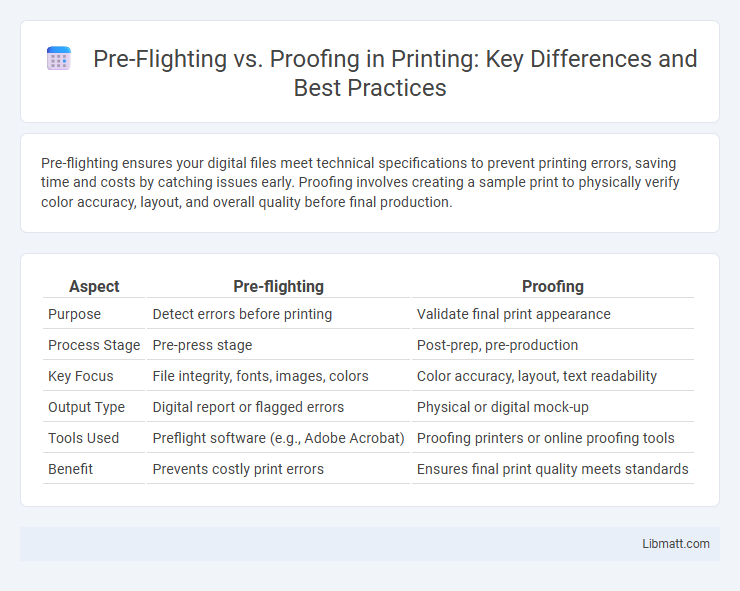Pre-flighting ensures your digital files meet technical specifications to prevent printing errors, saving time and costs by catching issues early. Proofing involves creating a sample print to physically verify color accuracy, layout, and overall quality before final production.
Table of Comparison
| Aspect | Pre-flighting | Proofing |
|---|---|---|
| Purpose | Detect errors before printing | Validate final print appearance |
| Process Stage | Pre-press stage | Post-prep, pre-production |
| Key Focus | File integrity, fonts, images, colors | Color accuracy, layout, text readability |
| Output Type | Digital report or flagged errors | Physical or digital mock-up |
| Tools Used | Preflight software (e.g., Adobe Acrobat) | Proofing printers or online proofing tools |
| Benefit | Prevents costly print errors | Ensures final print quality meets standards |
Introduction to Pre-flighting and Proofing
Pre-flighting ensures your digital files are error-free before printing, checking elements like resolution, color modes, and fonts to avoid costly mistakes. Proofing involves reviewing physical or digital print samples to confirm accuracy in color, layout, and content before the final run. Understanding these processes helps you maintain quality control and streamline your print production workflow.
Understanding the Purpose of Pre-flighting
Pre-flighting is the critical process of verifying digital files before printing to ensure all elements such as fonts, images, colors, and layout meet technical specifications. By identifying issues like missing fonts, low-resolution images, or incorrect color profiles, pre-flighting prevents costly printing errors and delays. This step optimizes print readiness, saving time and resources while maintaining production quality.
What Does Proofing Involve?
Proofing involves carefully reviewing a final version of a document or design to identify errors in text, layout, color, and overall accuracy before printing or publishing. This process ensures that your content meets quality standards and matches client expectations, minimizing costly mistakes. Effective proofing uses specialized software or printed proofs to catch issues that pre-flighting might not detect, such as subtle typographical errors or color inconsistencies.
Key Differences Between Pre-flighting and Proofing
Pre-flighting involves checking digital files for technical errors such as resolution, fonts, color profiles, and file format compatibility before printing, ensuring the file meets all prepress requirements. Proofing focuses on generating a physical or digital sample to evaluate color accuracy, layout, and content correctness, allowing stakeholders to approve the final output before full production. The key difference lies in pre-flighting being a technical validation process, while proofing is a visual inspection to confirm overall print quality and design fidelity.
The Role of Pre-flighting in Print Quality Assurance
Pre-flighting is a critical step in print quality assurance that involves checking digital files for errors before printing, ensuring color accuracy, resolution, and correct fonts. This process helps you identify and fix potential issues such as missing images or incompatible color profiles, reducing costly errors and reprints. Effective pre-flighting enhances the overall print quality by confirming file readiness and compatibility with your printer's specifications.
Common Tools for Pre-flighting and Proofing
Common tools for pre-flighting include Adobe Acrobat Preflight, Enfocus PitStop Pro, and FlightCheck, which analyze digital files for errors such as missing fonts, color space issues, and image resolution problems. Proofing tools often involve physical and digital proof solutions like Epson large format printers, X-Rite color calibration devices, and software such as GMG ColorProof for accurate color validation. Integrating both pre-flighting and proofing tools streamlines print production workflows by minimizing errors and ensuring color accuracy before final output.
Pre-flighting Checklist: Essential Steps
A pre-flighting checklist ensures all design elements meet printing specifications before production, including verifying image resolution above 300 DPI, confirming color modes are set to CMYK, and checking for embedded fonts and proper bleeds. Essential steps also involve validating file formats, inspecting for missing links or low-quality images, and confirming page dimensions and margins align with printer requirements. This systematic review minimizes costly errors, enabling smooth workflow and high-quality print results.
Proofing Techniques for Error-Free Output
Proofing techniques for error-free output include hard copy proofs, digital proofs, and soft proofs that simulate the final print. You can use color calibration tools, check resolution and font consistency, and employ automated pre-flighting software to detect issues like missing fonts, incorrect color profiles, and image resolution problems. These steps ensure your final product meets quality standards and reduces costly errors before printing.
Benefits of Combining Pre-flighting and Proofing
Combining pre-flighting and proofing enhances print quality by catching technical errors and visual inconsistencies early in the production process. This integrated approach ensures file accuracy, color fidelity, and overall design integrity, reducing costly reprints and delays. Your workflow becomes more efficient, delivering flawless final output that meets client expectations and industry standards.
Best Practices for Efficient File Verification
Pre-flighting ensures your files meet all technical specifications before printing, such as checking color modes, image resolution, and font embedding to prevent costly errors. Proofing lets you verify the visual accuracy and layout by reviewing soft or hard copies for content, color fidelity, and design intent. Implementing a combined workflow of pre-flighting followed by thorough proofing guarantees efficient file verification and minimizes production delays.
Pre-flighting vs proofing Infographic

 libmatt.com
libmatt.com